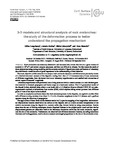3-D models and structural analysis of rock avalanches: the study of the deformation process to better understand the propagation mechanism
| dc.contributor.author | Longchamp, C | |
| dc.contributor.author | Abellan, A | |
| dc.contributor.author | Jaboyedoff, M | |
| dc.contributor.author | Manzella, Irene | |
| dc.date.accessioned | 2019-05-13T09:03:26Z | |
| dc.date.available | 2019-05-13T09:03:26Z | |
| dc.date.issued | 2016-09-28 | |
| dc.identifier.issn | 2196-6311 | |
| dc.identifier.issn | 2196-632X | |
| dc.identifier.uri | http://hdl.handle.net/10026.1/13845 | |
| dc.description.abstract |
<jats:p><p><strong>Abstract.</strong> Rock avalanches are extremely destructive and uncontrollable events that involve a great volume of material (&amp;gt;<span class="thinspace"></span>10<sup>6</sup><span class="thinspace"></span>m<sup>3</sup>) and several complex processes, and they are difficult to witness. For this reason the study of these phenomena using analog modeling and the accurate analysis of deposit structures and features of laboratory data and historic events become of great importance in the understanding of their behavior.<br><br>The main objective of this research is to analyze rock avalanche dynamics and deformation process by means of a detailed structural analysis of the deposits coming from data of 3-D measurements of mass movements of different magnitudes, from decimeter level scale laboratory experiments to well-studied rock avalanches of several square kilometers' magnitude.<br><br>Laboratory experiments were performed on a tilting plane on which a certain amount of a well-defined granular material is released, propagates and finally stops on a horizontal surface. The 3-D geometrical model of the deposit is then obtained using either a scan made with a 3-D digitizer (Konica Minolta VIVID 9i) or a photogrammetric method called structure from motion (SfM), which requires taking several pictures from different point of view of the object to be modeled.<br><br>In order to emphasize and better detect the fault structures present in the deposits, we applied a median filter with different moving window sizes (from 3<span class="thinspace"></span> × <span class="thinspace"></span>3 to 9<span class="thinspace"></span> × <span class="thinspace"></span>9 nearest neighbors) to the 3-D datasets and a gradient operator along the direction of propagation.<br><br>The application of these filters on the datasets results in (1) a precise mapping of the longitudinal and transversal displacement features observed at the surface of the deposits and (2) a more accurate interpretation of the relative movements along the deposit (i.e., normal, strike-slip, inverse faults) by using cross sections. Results show how the use of filtering techniques reveals disguised features in the original point cloud and that similar displacement patterns are observable both in the laboratory simulation and in the real-scale avalanche, regardless the size of the avalanche. Furthermore, we observed how different structural features, including transversal fractures and folding patterns, tend to show a constant wavelength proportional to the size of the avalanche event.</p> </jats:p> | |
| dc.format.extent | 743-755 | |
| dc.language | en | |
| dc.language.iso | en | |
| dc.publisher | European Geosciences Union | |
| dc.title | 3-D models and structural analysis of rock avalanches: the study of the deformation process to better understand the propagation mechanism | |
| dc.type | journal-article | |
| dc.type | Journal Article | |
| plymouth.author-url | https://www.webofscience.com/api/gateway?GWVersion=2&SrcApp=PARTNER_APP&SrcAuth=LinksAMR&KeyUT=WOS:000385382400001&DestLinkType=FullRecord&DestApp=ALL_WOS&UsrCustomerID=11bb513d99f797142bcfeffcc58ea008 | |
| plymouth.issue | 3 | |
| plymouth.volume | 4 | |
| plymouth.publication-status | Published online | |
| plymouth.journal | Earth Surface Dynamics | |
| dc.identifier.doi | 10.5194/esurf-4-743-2016 | |
| plymouth.organisational-group | /Plymouth | |
| plymouth.organisational-group | /Plymouth/Faculty of Science and Engineering | |
| plymouth.organisational-group | /Plymouth/Faculty of Science and Engineering/School of Geography, Earth and Environmental Sciences | |
| plymouth.organisational-group | /Plymouth/REF 2021 Researchers by UoA | |
| plymouth.organisational-group | /Plymouth/REF 2021 Researchers by UoA/UoA07 Earth Systems and Environmental Sciences | |
| plymouth.organisational-group | /Plymouth/Users by role | |
| plymouth.organisational-group | /Plymouth/Users by role/Academics | |
| plymouth.organisational-group | /Plymouth/Users by role/Researchers in ResearchFish submission | |
| dcterms.dateAccepted | 2016-08-19 | |
| dc.identifier.eissn | 2196-632X | |
| dc.rights.embargoperiod | Not known | |
| rioxxterms.versionofrecord | 10.5194/esurf-4-743-2016 | |
| rioxxterms.licenseref.uri | http://www.rioxx.net/licenses/all-rights-reserved | |
| rioxxterms.licenseref.startdate | 2016-09-28 | |
| rioxxterms.type | Journal Article/Review |


